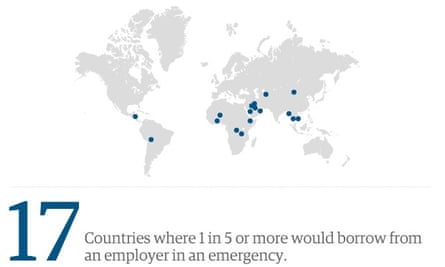On average, two in five people around the world took out a loan in 2013-14, with South Africa, where 86% of adults needed to borrow money last year, being the world’s number one country for people needing loans.
But there’s a huge divide between how and why people in the global north and global south borrow, according to the 2014 Global Findex database, which was published last month.
The World Bank Gallup survey asked 150,000 adults in 143 countries how they access financial services. It’s not the first time people have been polled about whether they have a bank account or savings (that was 2011) but this year’s survey was the first time there was a focus on how people would raise money in a disaster.
When asked: “Imagine you had an emergency – if you had to raise X amount (1/20 of your country’s gross national income) in the next month, where would you go for money?” it’s perhaps unsurprising that few people would turn to banks for an emergency loan. In fact, in 31 countries, fewer than 1% of people would borrow from a bank. This is most likely because in many developing countries physical bank branches are few and far between.
Instead, this is where most people would borrow their money from: the bank of mum and dad
This article includes content hosted on guardian-professional.cartodb.com. We ask for your permission before anything is loaded, as the provider may be using cookies and other technologies. To view this content, click 'Allow and continue'.
Borrowing from family in an emergency proved the most popular option in Latin America, north America, south-east Asia, Russia and eastern Europe with more than 50% of adults in Niger, Mauritania, Bhutan, Turkmenistan, Azerbaijan, Moldova, Macedonia and Montenegro saying they would head first to family for emergency funds.
But what about the countries shown in light blue, where people are less prone to borrowing from their families? There’s an interesting western divide here - if you’re from the US, northern Europe, China or Australia, you don’t need to rely on your family. This is probably because you have savings, making you more financially resilient if a medical emergency or natural disaster strikes.
Would you feel comfortable borrowing money from your employer?
Not everyone would borrow from family in an emergency, and not everyone has savings. In countries with little formal financial infrastructure, you’d expect the next port of call to be an informal lender or loan shark. But actually, that person could be your boss if you live in any of the following 17 countries.

Where does that borrowed money go?
The Findex survey also asked people who had taken out a loan in the past year what they’d spend it on. In the countries coloured dark blue, the priority for adults is getting a mortgage with their loan. But interestingly, the further south you go, the more reliant people are on loans for covering what should be basic public services such as health and education.
This article includes content hosted on guardian-professional.cartodb.com. We ask for your permission before anything is loaded, as the provider may be using cookies and other technologies. To view this content, click 'Allow and continue'.
But while payday loans are growing in the west and there’s also an ongoing expansion of microcredit institutions in developing countries, credit is not the safest way of raising money quickly. One in three people in 39 countries simply said they would be unable to raise money in an emergency.

For those working in development and policy though, perhaps the most valuable finding to take from the Findex survey, is that there are still far too few people who have a financial safety net if disaster strikes. In 21 countries, less than 10% of the population would use their savings to raise emergency funds. And even in the richest countries, such as the UK and US, only 49% and 40% respectively would head to their savings first in a crisis.
This article includes content hosted on guardian-professional.cartodb.com. We ask for your permission before anything is loaded, as the provider may be using cookies and other technologies. To view this content, click 'Allow and continue'.
Join our community of development professionals and humanitarians. Follow @GuardianGDP on Twitter. Have you borrowed from family or an employer? Tweet us your experiences, using #NOunbanked